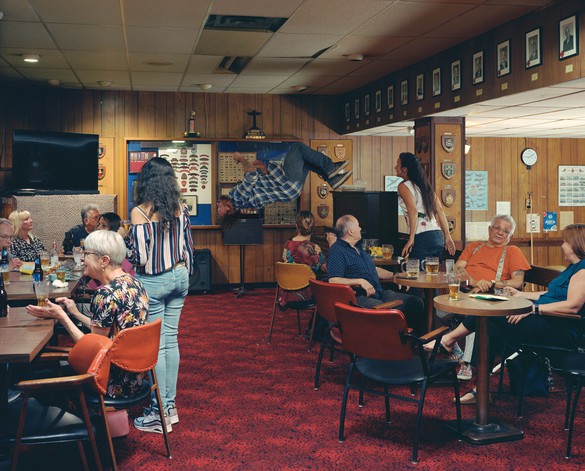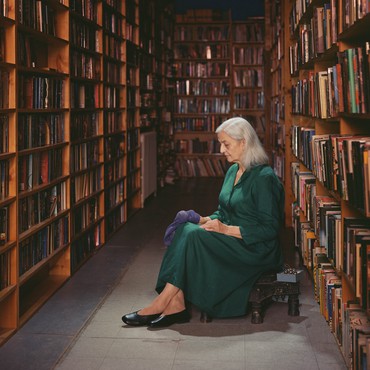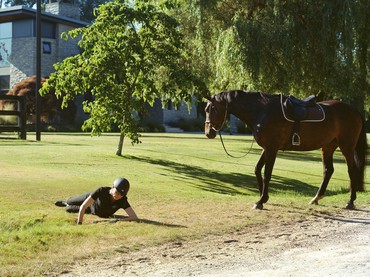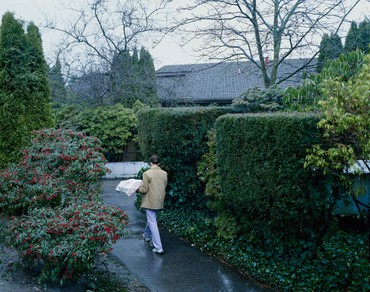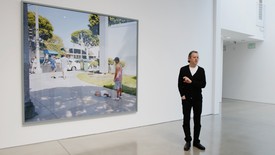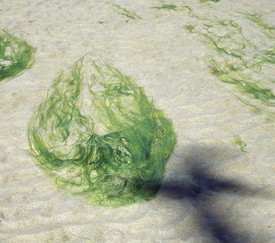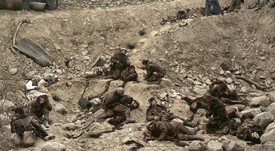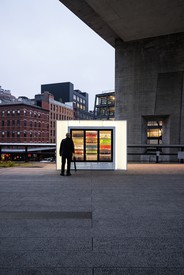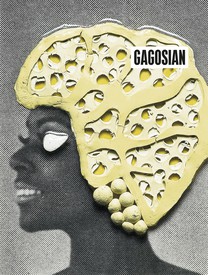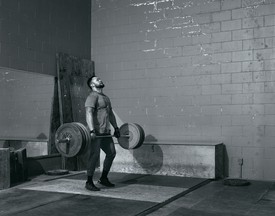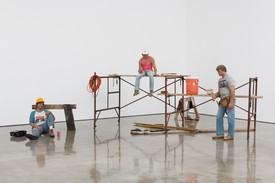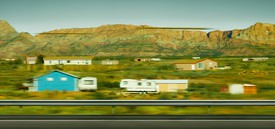
Barry Schwabsky is art critic for The Nation, international reviews editor for Artforum, and has recently contributed to publications on Pierre Bonnard, Issy Wood, Rose Wylie, and others. His recent books include two collections of poetry, Water from Another Source (Spuyten Duyvil, 2023) and Feelings of And (Black Square Editions, 2022).
Jeff Wall has been making the work he recognizes as his since 1978, and it has drawn widespread international attention since 1981, with countless gallery and museum exhibitions as well as important publications. Many of his photographs are now familiar to lovers of contemporary art. He himself has often had occasion to reencounter them—probably, come to think of it, more than anyone else has. So it’s meaningful that when asked recently what he’s most proud of about his work, Wall replied (after pointedly substituting the humbler word “satisfied” for the more arrogant “proud”—clearly success has not deprived him of the stereotypical Canadian modesty), “I feel there’s a liveliness to the pictures for the most part; they don’t seem to have grown old. They feel like things I’d still like to make.”
That’s a true artist talking: when something is good, he doesn’t just want to see it, he wants to make it. And that’s true even if he has already made it. Why not make it again? Like Henri Matisse, who once said, “I do not repudiate any of my paintings, but there is not one of them that I would not redo differently, if I had it to redo.” Although Matisse often made several versions of a painting as part of a single effort, he didn’t really go back and make new versions of his old works, as some artists have, among them Giorgio de Chirico and Edvard Munch, who painted The Sick Child six times between 1885 and 1925. With only two exceptions that I know of—more about one of them later—Wall has never redone one of his old pictures. And yet as often as one may have seen them, they still look new, or rather more than new—one might almost say, unsettled, open-ended, still to be made.
As I write this, in December 2023, Wall’s latest retrospective has yet to open at the Fondation Beyeler, near Basel, Switzerland, where it will be on view through April 21. Curated by Martin Schwander, it comprises fifty-four works made from 1982 onward, which is to say more than a quarter of the artist’s mature oeuvre. Since it still lies in my future, I can’t say—can’t predict—in what ways the pictures there will look different to me, should I be lucky enough to get to the show.
But I can tell something, I think, about how Wall himself is seeing his work differently, thanks to his contribution to its catalogue: unusually, he has contributed a commentary on each of the works displayed, often explaining something about what inspired them and about the circumstances under which they were made. We come to understand, among many other things, that his synthesis of memory and imagination often calls for him to find a place similar to the one in which he witnessed a certain occurrence, and then also to find a person who resembles the one he’d seen. This is more than just a purely pragmatic requirement; sometimes the idea whose germ lay in a passing observation can be more vividly or deeply developed by a certain shift. Or at least that’s how I interpret Wall’s remark that his 2021 photograph Event, which shows a somewhat mysterious confrontation between two similarly dressed bearded men, needed a completely different setting. “That transfer would not only be physical, geographical,” he explains, “but social as well. I assumed the freedom to discover another circumstance that would somehow disclose what I felt about what I’d seen, even though it would not tell us anything about the original situation.” Although we often feel that photography’s truth is in its resemblance to the fact, Wall locates it in its resemblance to a feeling about a fact.
In this way, Wall’s practice plunges him into the paradoxes of the similar: anything can be like anything else in some way or another, but equally things can all be seen as unlike. Intuition is the sole judge. In likeness, writes the philosopher Paul North, “The world gets edited, a gap gets spliced out, one character shimmies up to another. A thing, distant in space from another thing, overlaps with the other thing in one or more of its qualities.” No wonder Wall’s realistic fictions provoke us to wonder where the border between real and fictive is to be found in them. His work is nourished by observation just as much as that of photographers such as Robert Frank or Garry Winogrand, for whom he expresses the greatest admiration. But observation comes into it in an oblique way, as it might for a writer of stories, for instance, who doesn’t merely record something seen, as a journalist or diarist might, but finds in it clues to something unseen, and then transmutes the observed fact in such a way as to find a specifically artistic sense for it. That’s something that can’t be predetermined.
Wall has often spoken of some of his photographs as being “near documentary,” a phrase in which I hear the echo of Walker Evans’s “documentary style.” For both of them there has been a sort of approach-avoidance ambivalence to the idea of the document. They want what the poet Marianne Moore called “imaginary gardens with real toads in them”—or is it the other way round: real gardens with imaginary toads? The garden, in any case, is the veritable emblem of the intertwining of culture—of cultivation—with nature. And there’s as much artifice involved in maintaining an English garden, with its fiction of wildness and informality, as a French garden, with its decorous rectilinear layout. Gardens have been an occasionally recurrent theme for Wall, most explicitly with the triptych I Giardini/The Gardens (2017), his largest work so far. The orderly garden becomes the setting for conflict, and in the triptych’s last panel it appears that those who believed they were in control are somehow both trapped within it and evicted from it.
Another work set in a garden is A woman with a covered tray (2003), which Wall has characterized as exemplifying his idea of “urban pastoral.” In a paradoxical way, this picture makes a point of withholding its point. A path cuts diagonally through the scene’s impressive greenery—from bottom right to upper left, which is perhaps to say (since we read left to right and not right to left) into the past. A young woman walks this path into the distance, perhaps toward a building of which we see only the roof tiles, her back to the camera as she carries a tray entirely covered by a white cloth. The sky is overcast, the ground damp. We learn from Wall’s commentary that the setting is “a walkway between two buildings of a large residential facility for the elderly,” but I don’t think that specificity is necessary for the viewer to perceive the sense of care, almost of ceremony, embodied by the tray-bearer—especially since this is another work in which Wall chose a setting different from that of his initial observation. But who she is, where she is going, and what she is carrying remain unknown. Perhaps this is allegory for the mysterious and elusive role of “content” in the work of art.
I mentioned before that Wall had just twice remade a work. One of them now bears the title An Eviction and the dates 1988/2004. (In its first form it was titled Eviction Struggle; the current version was made as a digital montage using material photographed during the original shoot, in 1988.) Its subject can be thought of as counterpointing the expulsion that concludes I Giardini/The Gardens. It is anything but a pastoral. Far from depicting a hortus conclusus, it encompasses a vast space: here it’s not a footpath but a road, again running from bottom right to upper left, through what appears to be a working-class suburb (though one house on the street is rather grander in scale than the others) and leading diagonally into the distance. Behind the houses runs an elevated rapid-transit track, and beyond that one can see a city sprawling toward the far horizon. One notices first the nearest house, on the right: it is the only one with the pride of a picket fence around its front yard. But the tiny man and tricycle-riding boy in front of it are not caught up in the eviction mentioned in the title; like the foreground figures in Bruegel’s Landscape with the Fall of Icarus (c. 1560), they have their own thoughts to attend to. The brouhaha, the struggle, is taking place among a group of even tinier figures at the picture’s midpoint: two men grab the arms of a third as a woman comes running up, her arms outstretched, her pose like something out of a Baroque painting. And yet what counts more is precisely the stance of the people who are not involved: the most significant change that Wall made to this composition—at least as far as I can tell from comparing the present work with a thumbnail of its original state—was precisely to add the indifferent figures in the foreground while removing one who was more evidently observing the eviction.
I think it’s clear that on purely compositional grounds, An Eviction is a stronger picture than Eviction Struggle, but does the change also create a different meaning? Not so much different as sharper. What might be called the secondariness of the nominally (and compositionally) central narrative takes on an even more pointedly ironic significance. That this is so makes it even more intriguing that Wall has only once made such a “correction” again, with Trân Dúc Ván (1988/2003; not in the Beyeler exhibition). Perhaps that’s because, in the domain of likeness where Wall’s pictures live, things can always be otherwise, and perhaps improved, but there is no criterion of correctness—only the truth of feeling.
Jeff Wall, Fondation Beyeler, Riehen/Basel, Switzerland, January 28–April 21, 2024
Artwork © Jeff Wall
